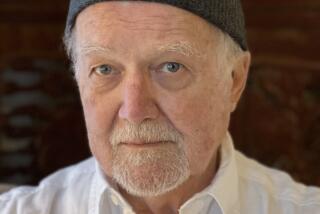Scotland Relishes Mystique of Robert Burns as His Bicentennial Nears : Literature: Many a commemoration is being readied for 1996, 200 years after the beloved poet’s death.
- Share via
ALLOWAY, Scotland — On a wintry evening, fat snowflakes fall on the thatched roof of a three-room stone cottage by a country road. Inside, a cow and some chickens rustle in their stalls. In the adjacent room, a family gathers around a fire to hear father read Scripture by candlelight.
Listening with an expression of rapt attention is a curly-haired 8-year-old boy who is destined to become the national poet of Scotland--and among the most intensely adored figures in English literature.
The 18th-Century people and animals are replicas in wax. But the cottage is the real birthplace of Robert Burns, whose fans consider one of the greatest writers in the language--and whose reputation for genius, passion and excess continues to intrigue readers to this day.
The recently installed tableau of Burns’ early life is complete with sound effects and some of the cottage’s original furnishings, including the bed in which Burns was born in 1759 and the chair in which he was nursed.
This refurbishment of the poet’s childhood home is only one of an outpouring of commemorations being readied in Scotland and around the world in anticipation of the 1996 bicentennial of Burns’ death at age 37.
Devotees annually observe “Burns Night” on or about the date of the poet’s birth, Jan. 25. During these events, his works are recited, sung and discussed amid the playing of bagpipes, eating of traditional Scottish dishes such as haggis (a meat pudding) and, typically, much drinking of Scotch whiskey.
At least two international conferences are being planned for the bicentennial to reassess the poet’s life, works and legacy. One will be held at the University of Strathclyde in Glasgow. The other will be at the University of South Carolina in Columbia, site of the most extensive collection of printed Burns materials in North America.
The National Library of Scotland will open a major traveling exhibition of Burns memorabilia in Edinburgh, and a motion picture about the poet’s life is being planned.
Around the world, about 600 Burns societies are expected to hold special observances of the bicentennial.
“It’s totally remarkable,” said Burns scholar G. Ross Roy of the University of South Carolina, comparing the poet’s near-cult status to other noted writers. “How many Milton clubs are there?”
John Manson, curator of the Burns cottage and adjacent museum in Alloway, attributes the fascination to the mystique that surrounds the poet.
“It’s partly the popularity of his marvelous songs and poems,” Manson said, “and partly the fact that he had a short, full, rich life. He had a lot of bad press about being a hard drinker and womanizer, which is not really strictly true.”
The matter of Burns’ passions is one of continuing controversy. Although he evidently went through a succession of lovers, for each of whom he professed undying devotion, some scholars believe his reputation as a rounder was somewhat contrived.
“Burns was a theatrical personality,” said J. Derrick McClure of the University of Aberdeen. “He himself exaggerated some of these things. But, at core, he was thoroughly honest and very sincere about his fondness for his home, his family and the common people. He was very sincerely a champion of the rights of oppressed people.”
Son of a tenant farmer, young Burns came under the influence of a gifted teacher, John Murdoch, who awakened his interest in language and literature. Betty Davidson, an elderly woman who lived with the family, stimulated his imagination with her stories and songs of Scottish history and folklore.
Burns began writing poems at age 14. Prophetically, his first began with the line, “Once I loved a bonnie lass.”
By 26, his talent matured and he was writing some of his finest work, including “The Jolly Beggars,” “The Cotter’s Saturday Night,” “To a Mouse” and the acclaimed satire on religious hypocrisy, “Holy Willie’s Prayer.”
Burns’ themes of egalitarianism and the natural nobility of the common man, exemplified in “A Man’s A Man for A’ That,” earned him a hallowed place in popular political movements throughout the world, including revolutionary Russia.
Whether he would have approved of the Soviet government, however, is debatable. An early supporter of the French Revolution--he once tried to donate a cannon to the cause--Burns turned against what it became and railed against its excesses.
Modern readers find some of Burns’ poetry tough going, since he wrote much of his best work in the lowland Scottish dialect he grew up speaking. A glossary is advised.
But many poems, such as “My Love Is Like a Red, Red Rose,” are accessible and timeless.
“I think that is one of the greatest songs in English,” said Roy. “It’s 16 lines long, with one three-syllable word, seven two-syllable words, and the rest all one-syllable words. To make an immortal song out of that simple material is something that has always appealed to people.”
After a period of deteriorating health, Burns died July 21, 1796, of rheumatic fever, surrounded by his wife, Bonnie Jean, and five children.
One of the songs he left behind has become a New Year’s tradition around the world:
For auld lang syne, my dear,
For auld lang syne.
We’ll tak’ a cup o’ kindness yet,
For auld lang syne.
More to Read
Sign up for The Wild
We’ll help you find the best places to hike, bike and run, as well as the perfect silent spots for meditation and yoga.
You may occasionally receive promotional content from the Los Angeles Times.






